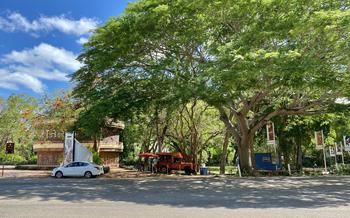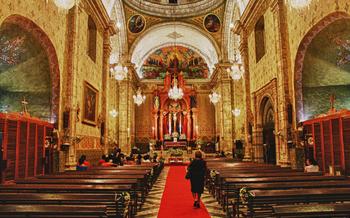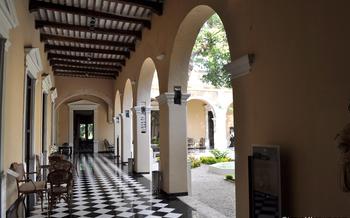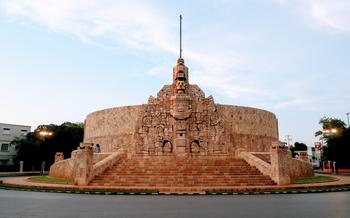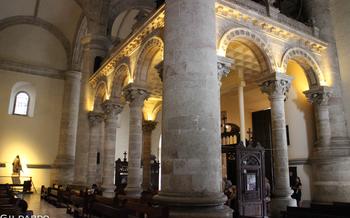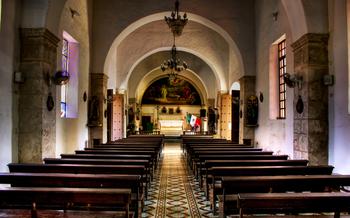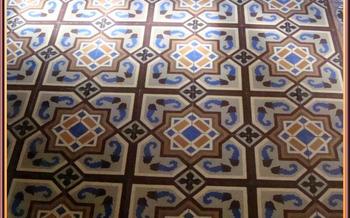
Casa de Montejo
- Historical Significance: A Timeless Legacy
- Architectural Marvel
- Cultural Center
- Museo Casa de Montejo:
- Guided Tours
- Location and Accessibility
- Admission Fees and Hours of Operation:
- Dress Code and Etiquette
- Photography and Videography
- Souvenirs and Gift Shop
- Accessibility for Individuals with Disabilities:
- Food and Drinks:
- Restrooms and Facilities:
- Events and Festivals
- Insider Tip:
Historical Significance: A Timeless Legacy
In the heart of Merida, Yucatan, stands the Casa de Montejo, a testament to the rich history and cultural heritage of Mexico. Built in the 1540s by the wealthy conquistador Francisco de Montejo, this architectural masterpiece holds a significant place in the annals of Mexican history. As one of the first stone structures in Merida, the Casa de Montejo embodies the fusion of Spanish and Mayan influences, showcasing a unique blend of Renaissance and pre-Columbian architectural styles.
The Casa de Montejo served as a symbol of Spanish power and wealth during the colonial era, reflecting the grandeur and opulence of the Spanish conquistadors. Over the centuries, the building underwent several renovations and restorations, each adding its own layer of history and cultural significance. Today, the Casa de Montejo stands as a restored treasure, preserving its original grandeur and offering visitors a glimpse into the fascinating past of Mexico and the Yucatan Peninsula.
Architectural Marvel
The Casa de Montejo stands as a testament to the architectural prowess of the Spanish and Maya. Its intricate facade, adorned with carvings depicting scenes from the Spanish conquest and Mayan mythology, captivates the eyes of all who behold it. The unique blend of Spanish and Mayan architectural elements, such as the Plateresque doorway and the corbelled arches, showcases the cultural exchange that occurred during the colonial era. The skillful craftsmanship and attention to detail displayed in the building's construction are simply breathtaking, making the Casa de Montejo a true architectural masterpiece. It serves as a reminder of the rich history and cultural heritage that shaped the Yucatan Peninsula.
Cultural Center
The Casa de Montejo has undergone a remarkable transformation from a private residence to a vibrant cultural center. Today, it serves as a platform for showcasing the rich cultural heritage of Mexico, particularly the Yucatan region. The building's grand halls and elegant courtyards provide a fitting backdrop for a diverse range of cultural programs and events.
Visitors can immerse themselves in art exhibitions that showcase the works of local, national, and international artists. The Casa de Montejo also hosts regular concerts featuring traditional Mexican music, such as mariachi and trova, as well as contemporary genres. For those seeking a deeper connection with Mayan culture, the center offers captivating traditional dance performances that bring to life the stories and legends of the ancient Maya.
Beyond these public events, the Casa de Montejo plays a crucial role in promoting cultural education and engagement within the local community. Educational programs and workshops are organized for students, families, and individuals of all ages. These programs aim to foster a greater understanding and appreciation of Mexican history, art, and traditions, ensuring that the cultural legacy of the Yucatan region continues to thrive for generations to come.
Museo Casa de Montejo:
Housed within the walls of the Casa de Montejo, the Museo Casa de Montejo invites visitors to delve deeper into the captivating history and significance of this iconic landmark. The museum's collection of artifacts, furniture, and paintings offers a glimpse into the opulent lifestyle of the Montejo family, the Spanish conquistadors who played a pivotal role in shaping the region's destiny. Through interactive exhibits and displays, the museum brings to life the daily lives of the Maya and Spanish inhabitants, shedding light on the cultural exchange and fusion that characterized this era. As you wander through the museum's galleries, you'll gain a profound appreciation for the rich cultural heritage of Yucatan and the enduring legacy of the Casa de Montejo.
Guided Tours
To gain a deeper understanding of the Casa de Montejo's rich history, architecture, and cultural significance, booking a guided tour is highly recommended. Several tour options are available, catering to different interests and preferences. Group tours provide a comprehensive overview of the site, while private tours offer a more personalized experience with a knowledgeable guide. Audio guides are also available for self-guided exploration, allowing visitors to learn at their own pace.
I had the privilege of participating in a guided tour of the Casa de Montejo, and it was an incredibly enriching experience. Our guide, a passionate historian, brought the building's past to life with captivating stories and insights. We learned about the Montejo family's role in the conquest of Yucatan, the unique blend of Spanish and Mayan architectural elements, and the building's transformation into a cultural center.
The tour highlighted intricate details that I would have missed on my own, such as the symbolic carvings on the facade depicting scenes from the Spanish conquest and Mayan mythology. Our guide explained the significance of these carvings, providing a deeper understanding of the cultural exchange that took place during the colonial era.
Booking a guided tour is an excellent way to make the most of your visit to the Casa de Montejo. Whether you opt for a group tour, a private tour, or an audio guide, you'll gain valuable insights and a deeper appreciation for this architectural gem.
Location and Accessibility
The Casa de Montejo is conveniently located in the heart of Merida's historic center, on Calle 60 between Calle 61 and Calle 6It is easily accessible on foot, allowing visitors to explore the surrounding colonial architecture and vibrant atmosphere of the city.
For those using public transportation, the Casa de Montejo is within walking distance of several bus stops. Alternatively, taxis are readily available and can drop visitors directly in front of the building.
While exploring the area, visitors can combine their visit to the Casa de Montejo with other nearby attractions, such as the Merida Cathedral, the Plaza Grande, and the Palacio de Gobierno. A leisurely stroll through the historic center reveals charming streets, colorful buildings, and hidden gems waiting to be discovered.
Admission Fees and Hours of Operation:
Visiting the Casa de Montejo is an affordable cultural experience. The admission fee is currently 70 pesos for general admission, with discounts available for students, seniors, and children. The site is open to the public from Tuesday to Sunday, from 9 am to 5 pm. Guided tours are available for an additional fee and can be booked in advance or upon arrival. To avoid crowds and enjoy a more personalized experience, it is recommended to visit during the weekdays or early in the morning. Check the official website or contact the Casa de Montejo directly for the most up-to-date information on admission fees, hours of operation, and any special events or exhibitions.
Dress Code and Etiquette
When visiting the Casa de Montejo, it is essential to be mindful of the cultural significance of the site and to behave appropriately. While there is no strict dress code, visitors should dress respectfully, avoiding revealing or overly casual attire. It is important to remember that the Casa de Montejo is an active cultural center and a place of work for its staff. Visitors should be respectful of others by keeping noise levels down and refraining from touching or leaning on artifacts or exhibits. Photography and videography are permitted, but visitors should be mindful of the privacy of other visitors and obtain permission before taking their photos. Flash photography and tripods are not allowed inside the museum. Visitors are encouraged to be respectful of the Casa de Montejo's cultural heritage and to contribute to its preservation by following these simple guidelines.
Photography and Videography
The Casa de Montejo welcomes photography and videography for personal use, allowing visitors to capture the beauty and grandeur of the building and its exhibits. However, it's essential to respect the privacy of other visitors and obtain permission before taking their photos or videos. Using tripods or professional photography equipment may require prior authorization, and visitors should inquire with the Casa de Montejo staff for specific guidelines.
Flash photography is generally not permitted inside the museum to preserve the artifacts and artworks. Natural light provides ample illumination for capturing stunning images, and visitors can adjust their camera settings accordingly. The intricate facade of the Casa de Montejo offers a picturesque subject for photography, especially during the golden hour of sunrise or sunset.
To capture the essence of the building's interior, focus on the architectural details, such as the Plateresque doorway, the corbelled arches, and the intricate carvings adorning the walls. Photographs of the museum's exhibits, including artifacts, paintings, and furniture, provide a glimpse into the history and lifestyle of the Montejo family and the colonial era.
Sharing photographs and videos of the Casa de Montejo on social media platforms can help promote the site and its cultural significance. Visitors are encouraged to tag the Casa de Montejo and use relevant hashtags to connect with other travelers and share their experiences.
Souvenirs and Gift Shop
At the Casa de Montejo, visitors can immerse themselves in the vibrant culture of Mexico by purchasing unique souvenirs and gifts from the on-site gift shop. This treasure trove offers a diverse selection of items, including books that delve into the history and significance of the Casa de Montejo and the Yucatan region. Postcards adorned with stunning images of the building's intricate facade and the surrounding colonial architecture provide a lasting reminder of the visit.
Handicrafts crafted by local artisans showcase the rich traditions and skills of the Maya and Mexican cultures. Visitors can find intricate textiles, colorful pottery, and hand-carved wooden figurines that embody the region's artistic heritage. Replicas of Mayan artifacts, such as jade jewelry and ceramic figurines, offer a tangible connection to the ancient civilization that once thrived in this land.
By purchasing souvenirs from the Casa de Montejo, visitors not only take home a piece of Mexican culture but also contribute to the preservation and promotion of the country's rich heritage. The proceeds from the gift shop support ongoing restoration efforts and educational programs, ensuring that the Casa de Montejo continues to be a vibrant cultural center for generations to come.
Accessibility for Individuals with Disabilities:
The Casa de Montejo is committed to ensuring that all visitors, regardless of their abilities, can enjoy and appreciate the site. The building is wheelchair-accessible, with ramps and elevators providing access to all levels. Accessible restrooms are also available for the convenience of visitors with disabilities.
For visitors with visual impairments, audio guides are available to provide detailed information about the history, architecture, and cultural significance of the Casa de Montejo. Additionally, sign language interpreters can be arranged upon request to assist visitors with hearing impairments.
The Casa de Montejo's staff is dedicated to providing a welcoming and inclusive environment for all visitors. If you have any specific accessibility needs or concerns, please do not hesitate to contact the site in advance to make arrangements.
Food and Drinks:
The Casa de Montejo lacks on-site dining options, but visitors can easily find an array of food and beverage choices nearby. Merida's culinary scene offers a delightful blend of traditional Yucatecan cuisine and international flavors. For a taste of local delicacies, head to nearby restaurants serving traditional dishes such as cochinita pibil, panuchos, and salbutes. Budget-conscious travelers can explore the vibrant street food scene, where vendors offer delicious and affordable snacks like tacos, tortas, and esquites. To stay hydrated in the warm Yucatan climate, bring your own water bottle or purchase refreshments from nearby shops.
Restrooms and Facilities:
The Casa de Montejo is equipped with clean and well-maintained restrooms for the convenience of visitors. These facilities are strategically located to ensure easy accessibility from different parts of the building. Visitors can also find baby changing stations within the restrooms, making it a family-friendly destination. To maintain cleanliness and hygiene, it is essential to follow the posted guidelines and regulations. Respecting the property and refraining from causing any damage is crucial for preserving the integrity of this historic site.
Events and Festivals
The Casa de Montejo comes alive during special events, festivals, and exhibitions that showcase the rich cultural heritage of Mexico and the Yucatan region. Throughout the year, visitors can experience a variety of events that celebrate art, music, dance, and history.
One of the most popular events is the annual "Noche Mexicana," held on September 15th, which commemorates Mexico's Independence Day. The Casa de Montejo transforms into a vibrant festival ground, featuring traditional music performances, folkloric dance shows, food stalls, and craft markets. Visitors can immerse themselves in the festive atmosphere and celebrate Mexican culture alongside locals.
Another highlight is the "Festival de la Primavera," held in March or April, which celebrates the arrival of spring. The Casa de Montejo hosts concerts, workshops, art exhibitions, and cultural performances that showcase the diverse talents of local artists and performers. Visitors can enjoy live music, learn about traditional Mayan customs, and participate in interactive activities.
For those interested in history and archaeology, the Casa de Montejo often hosts conferences, seminars, and workshops related to the Maya civilization and the colonial era. These events provide a platform for experts and scholars to share their research and insights, and visitors can gain a deeper understanding of the region's rich past.
Keep an eye out for special exhibitions that showcase unique artifacts, artworks, or historical documents related to the Casa de Montejo or the Yucatan region. These exhibitions offer a rare opportunity to learn about the site's history, cultural significance, and ongoing preservation efforts.
Attending events at the Casa de Montejo is a fantastic way to experience the vibrant cultural scene of Merida and Yucatan. Whether you're interested in music, dance, art, or history, there's something for everyone to enjoy. So, be sure to check the official website or contact the Casa de Montejo directly for information on upcoming events and festivals.
Insider Tip:
Uncover the secret courtyard hidden within the Casa de Montejo, a tranquil oasis adorned with lush greenery and a refreshing fountain. Escape the bustling city streets and find solace in this secluded sanctuary, where you can sit on a bench and soak in the peaceful ambiance. Take a moment to appreciate the intricate details of the building's architecture, reflected in the serene waters of the fountain. This hidden gem offers a unique perspective and a chance to connect with the Casa de Montejo's rich history and cultural significance.
